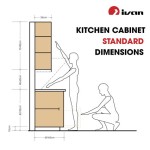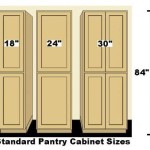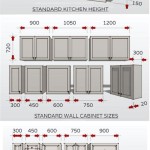How To Clean Sticky Grease Off Laminate Kitchen Cabinets
Laminate kitchen cabinets are a popular choice for many homeowners due to their affordability, durability, and aesthetic versatility. However, their location in the kitchen invariably exposes them to grease splatters, cooking fumes, and general grime, leading to a sticky residue that can be difficult to remove. This sticky buildup not only detracts from the cabinets' appearance but can also attract dust and other particles, making the problem worse over time. Understanding the nature of this grease and the proper cleaning techniques is essential for maintaining clean and attractive laminate kitchen cabinets.
The stickiness associated with kitchen grease is primarily caused by the oxidation of fats and oils released during cooking. When heated, these substances vaporize and can land on surfaces like cabinets. As they cool, they solidify and react with oxygen in the air, transforming into a viscous, adhesive layer. This layer traps airborne contaminants, further contributing to the sticky texture and often discolored appearance. The composition of the laminate surface itself also plays a role. Laminate, while relatively non-porous, can still have microscopic imperfections that trap grease and make it more difficult to remove with simple wiping.
The key to effectively cleaning sticky grease from laminate cabinets lies in a combination of appropriate cleaning solutions, proper application techniques, and preventative measures. This article outlines a step-by-step approach to removing greasy buildup, offering various cleaning solutions and methods to address different levels of grime accumulation without damaging the laminate finish.
Understanding the Types of Cleaning Solutions
Selecting the right cleaning solution is crucial to achieving optimal results and preventing damage to the laminate surface. Several options are available, each with varying degrees of effectiveness and potential impact on the cabinet finish. It's always recommended to test a small, inconspicuous area before applying any cleaning solution to the entire cabinet.
Dish Soap and Water:
This is often the first and simplest approach to tackling grease. The mild detergents in dish soap are designed to cut through grease, making it an effective choice for light to moderate buildup. To use this method, mix a small amount of dish soap with warm water. Avoid using excessive soap, as it can leave a residue that requires additional rinsing.Baking Soda Paste:
Baking soda is a mild abrasive that can help loosen stubborn grease without scratching the laminate surface. To create a baking soda paste, mix baking soda with a small amount of water until a thick paste forms. Apply the paste to the greasy areas, let it sit for a few minutes, and then gently scrub with a soft cloth or sponge.Vinegar Solution:
Vinegar is a natural degreaser and disinfectant that can effectively remove grease and grime. Mix equal parts white vinegar and warm water in a spray bottle. Spray the solution onto the greasy areas and let it sit for a few minutes before wiping clean. The vinegar scent will dissipate quickly.Commercial Degreasers:
Numerous commercial degreasers are available specifically formulated for kitchen cleaning tasks. These products often contain stronger solvents that can effectively remove heavy grease buildup. When using commercial degreasers, always follow the manufacturer's instructions and wear gloves to protect the skin. Ensure the product is safe for use on laminate surfaces by checking the label.Steam Cleaners:
Steam cleaners utilize hot steam to loosen and dissolve grease and grime. The high temperature of the steam effectively breaks down the greasy residue, making it easier to wipe away. Steam cleaners are a chemical-free option and can be particularly useful for cleaning large areas or cabinets with intricate details.Avoid using abrasive cleaners, scouring pads, or harsh chemicals like bleach or ammonia, as these can damage the laminate surface, causing scratches, discoloration, or peeling.
Step-by-Step Cleaning Process
A systematic approach to cleaning sticky grease from laminate cabinets will ensure thoroughness and minimize the risk of damage. The following steps provide a comprehensive guide to cleaning greasy kitchen cabinets:
Step 1: Preparation:
Before starting, gather all the necessary cleaning supplies, including the chosen cleaning solution, soft cloths or sponges, a bucket of warm water, and paper towels. Protect the surrounding areas, such as countertops and floors, by covering them with drop cloths or old towels.Step 2: Initial Wipe Down:
Use a dry cloth or paper towel to remove any loose debris, dust, or crumbs from the cabinet surfaces. This will prevent these particles from scratching the laminate during the cleaning process.Step 3: Applying the Cleaning Solution:
Depending on the chosen cleaning solution, apply it to the greasy areas using a spray bottle, sponge, or cloth. For dish soap and water or vinegar solution, spray the solution directly onto the cabinets. For baking soda paste, apply the paste with a soft cloth or sponge. For commercial degreasers, follow the manufacturer's instructions.Step 4: Allowing the Solution to Soak:
Let the cleaning solution sit on the greasy areas for a few minutes to allow it to loosen the grease. The soaking time will vary depending on the severity of the grease buildup and the type of cleaning solution used. For light grease, a few minutes may be sufficient, while heavy grease may require a longer soaking time.Step 5: Scrubbing the Greasy Areas:
Gently scrub the greasy areas with a soft cloth or sponge. Avoid using excessive pressure, as this can damage the laminate surface. For stubborn grease, use a baking soda paste or a commercial degreaser specifically designed for heavy grease removal. Use circular motions when scrubbing to effectively lift the grease and grime.Step 6: Rinsing the Cabinets:
After scrubbing, rinse the cabinets with clean, warm water. Use a clean cloth or sponge to wipe away any remaining cleaning solution and grease residue. Ensure all traces of the cleaning solution are removed to prevent streaking or residue buildup.Step 7: Drying the Cabinets:
Thoroughly dry the cabinets with a clean, dry cloth or paper towel. This will prevent water stains and ensure the laminate surface is completely dry. Pay particular attention to edges and corners where water can accumulate.Step 8: Polishing (Optional):
For added shine, a laminate-safe polish can be applied after cleaning and drying the cabinets. Follow the manufacturer's instructions for applying the polish. This step is optional but can help to protect the laminate surface and enhance its appearance.Step 9: Cleaning Hardware:
Don't neglect the cabinet hardware. Remove knobs and pulls and soak them in warm, soapy water to remove grease and grime. Scrub with a soft brush, rinse, and dry thoroughly before reattaching them to the cabinets.Preventative Measures for Maintaining Clean Cabinets
Preventing grease buildup is just as important as removing it. Implementing preventative measures can significantly reduce the frequency and intensity of cleaning required, saving time and effort in the long run. Several strategies can be employed to minimize grease accumulation on laminate kitchen cabinets.
Using the Range Hood:
Always use the range hood while cooking, especially when frying or cooking with high heat. Range hoods effectively capture grease and cooking fumes before they can settle on surfaces like cabinets. Ensure the range hood filter is cleaned regularly to maintain its effectiveness.Wiping Splatters Immediately:
Promptly wipe up any grease splatters or spills as soon as they occur. The longer grease sits on surfaces, the harder it becomes to remove. Keep a damp cloth or sponge readily available for quick cleanup.Regular Cleaning Schedule:
Establish a regular cleaning schedule for the kitchen cabinets. Even if there are no visible signs of grease buildup, wiping down the cabinets with a damp cloth or mild cleaning solution once a week can prevent grease from accumulating and becoming difficult to remove.Strategic Placement of Appliances:
Consider the placement of appliances like toasters and blenders that can generate grease or food particles. Position them away from the cabinets or use splatter guards to prevent residue from landing on the surfaces.Ventilation:
Ensure adequate ventilation in the kitchen by opening windows or using a fan. Proper ventilation helps to remove cooking fumes and moisture, reducing the amount of grease that settles on surfaces.Protective Coatings:
Applying a laminate-safe protective coating or sealant can help to create a barrier that prevents grease from penetrating the surface. These coatings can also make it easier to wipe away grease and grime.By following these preventative measures and cleaning your laminate cabinets regularly with the appropriate solutions and techniques, it’s possible to keep them looking clean and attractive for years to come.

How To Clean Sticky Grease Off Kitchen Cabinets Infinity

Clean Sticky Grease Off Kitchen Cabinets In 5 Mins Or Less Torera George

How To Clean Sticky Grease Off Kitchen Cabinets Ovenclean

Clean Sticky Grease Off Kitchen Cabinets In 5 Mins Or Less Torera George

How To Quickly Clean Cabinets Remove Grease Gunk Andrea Jean

How To Clean Sticky Wood Kitchen Cabinets Easily Infinity

Easy Clean Grease Off Your Kitchen Cabinets

How To Deep Clean Kitchen Cabinets And Keep Them Looking Gorgeous Everyday Skate

How To Clean Sticky Grease Off Kitchen Cabinets Homemade Cleaning Solutions And Useful Tips

How To Clean Sticky Grease Off Kitchen Cabinets
Related Posts








